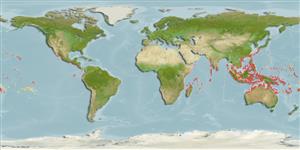Actinopterygii (ray-finned fishes) >
Perciformes (Perch-likes) >
Carangidae (Jacks and pompanos) > Caranginae
Etymology: Carangoides: French, carangue, the name of a Caribbean fish; 1836 (Ref. 45335). More on author: Bleeker.
Environment / Climate / Range
Ecology
Marine; brackish; reef-associated; depth range 1 - 22 m (Ref. 86942). Tropical, preferred ?; 32°N - 22°S
Indo-West Pacific: East Africa to Samoa, north to southern Japan, south to Tonga.
Size / Weight / Age
Maturity: Lm ? range ? - ? cm
Max length : 85.0 cm TL male/unsexed; (Ref. 48635); common length : 35.0 cm TL male/unsexed; (Ref. 9137); max. published weight: 2.6 kg (Ref. 3287)
Adults inhabit coastal waters. They occur singly or in small to large schools (Ref. 90102) at a depth of 15 m or less along steep drop-offs. Piscivore (Ref. 97629).
Life cycle and mating behavior
Maturity | Reproduction | Spawning | Eggs | Fecundity | Larvae
Smith-Vaniz, W.F., 1984. Carangidae. In W. Fischer and G. Bianchi (eds.) FAO species identification sheets for fishery purposes. Western Indian Ocean fishing area 51. Vol. 1. [pag. var.]. FAO, Rome. (Ref. 3287)
IUCN Red List Status (Ref. 115185)
CITES (Ref. 94142)
Not Evaluated
Threat to humans
Harmless
Human uses
Fisheries: minor commercial; gamefish: yes
More information
Common namesSynonymsMetabolismPredatorsEcotoxicologyReproductionMaturitySpawningFecundityEggsEgg development
ReferencesAquacultureAquaculture profileStrainsGeneticsAllele frequenciesHeritabilityDiseasesProcessingMass conversion
Tools
Special reports
Download XML
Internet sources
